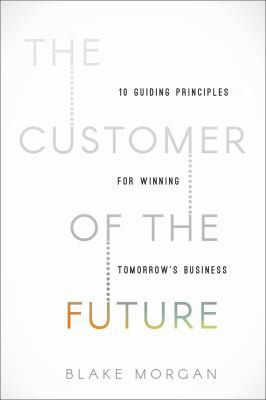Embracing the Future: Redefining Customer Experience
In “The Customer of the Future,” Blake Morgan delves into the shifting landscape of customer expectations and the necessity for businesses to adapt strategies to meet these evolving demands. Central to the narrative is the imperative that companies prioritize customer experience as a strategic cornerstone for success in an increasingly digital and customer-centric world. Morgan offers a comprehensive roadmap for organizations intent on transforming customer interactions and forging enduring relationships.
The Customer-Centric Paradigm Shift
The book begins with a focus on the paradigm shift towards customer-centricity. Morgan asserts that businesses can no longer afford to view customer service as a mere department; it must be ingrained in the organizational DNA. This shift demands a fundamental change in mindset, where every employee recognizes their role in delivering exceptional customer experiences.
Drawing parallels with “The Experience Economy” by Pine and Gilmore, Morgan emphasizes that experiences are now the marketplace’s key differentiator. Just as Pine and Gilmore argue that businesses should stage memorable events to create value, Morgan suggests that every interaction must be designed to enhance the customer experience. In “Outside In” by Manning and Bodine, the importance of understanding customer journeys is highlighted as essential to this transformation, aligning closely with Morgan’s emphasis on comprehensive customer experience strategies.
Leveraging Digital Transformation
Digital transformation is a central theme throughout the book. Morgan discusses how technological advancements, such as artificial intelligence (AI) and big data, are reshaping customer interactions. By leveraging these technologies, companies can gain profound insights into customer behavior and preferences, enabling them to deliver personalized experiences at scale.
This approach is akin to agile methodologies, where flexibility and responsiveness to changing customer needs are paramount. For instance, in “Digital Transformation” by Thomas M. Siebel, the notion of integrating new technologies to alter business models and provide new value-producing opportunities is similarly explored, reinforcing Morgan’s perspectives on adaptation and innovation.
Building a Culture of Innovation
Innovation is crucial for maintaining a competitive edge. Morgan stresses fostering a culture that encourages experimentation and embraces failure as a learning opportunity. This mirrors the ideas in “The Lean Startup” by Eric Ries, where iterative development and customer feedback are pivotal.
By cultivating an innovative mindset, companies can continuously enhance their offerings and surprise customers with novel solutions. An example of this is Google’s 20% time policy, which allows employees to spend a portion of their time on projects they are passionate about, leading to innovative products like Gmail and Google News.
Strategic Frameworks for Customer Engagement
Morgan introduces several strategic frameworks to guide organizations in their customer experience journey. One such framework involves mapping the customer journey to identify pain points and opportunities for enhancement. This approach aligns with the principles of design thinking, where empathy and understanding of the customer are paramount.
Systematically analyzing touchpoints enables businesses to create seamless and delightful experiences that foster loyalty. This is reminiscent of the framework detailed in “Value Proposition Design” by Osterwalder et al., where understanding customer jobs, pains, and gains is essential for crafting compelling value propositions.
The Role of Leadership in Transformation
Leadership plays a critical role in driving customer-centric transformation. Morgan argues that leaders must champion the cause, setting a clear vision and empowering employees to take ownership of the customer experience. This is akin to the servant leadership model, where leaders prioritize the needs of their teams and customers.
By embodying these principles, leaders can inspire a shared commitment to excellence across the organization. In “Leaders Eat Last” by Simon Sinek, the emphasis on leaders fostering an environment of trust and cooperation is echoed, further supporting Morgan’s stance on leadership’s pivotal role in transformation.
Adapting to the Digital Workplace
With the increasing digitalization of workplace environments, companies must adapt their internal processes to support remote and hybrid work models. Morgan explores how digital tools and platforms can enhance collaboration and communication, ensuring that employees remain connected and engaged.
This transformation is vital for maintaining productivity and delivering consistent customer experiences, regardless of physical location. The book “Remote: Office Not Required” by Jason Fried and David Heinemeier Hansson offers complementary insights into how businesses can thrive with distributed teams, reinforcing Morgan’s advocacy for digital adaptability.
Measuring Success and Continuous Improvement
Finally, Morgan emphasizes the importance of measuring success and striving for continuous improvement. She suggests using key performance indicators (KPIs) to track progress and identify areas for refinement. This data-driven approach allows organizations to make informed decisions and allocate resources effectively.
By fostering a culture of continuous learning, companies can stay ahead of the curve and meet the evolving needs of their customers. This notion is also explored in “Measure What Matters” by John Doerr, where the use of Objectives and Key Results (OKRs) is promoted to align effort with strategic goals, ensuring continuous organizational growth and adaptation.
Final Reflection: The Path Forward
“The Customer of the Future” serves as a comprehensive guide for organizations navigating the modern business landscape’s complexities. By embracing customer-centricity, leveraging technology, and fostering a culture of innovation, companies can build lasting relationships with customers and secure a competitive advantage.
Morgan’s insights provide a strategic blueprint for professionals aiming to transform their organizations and thrive in the digital age. This synthesis of ideas aligns with broader themes across domains such as leadership, design, and change management, underscoring the multifaceted approach required to address contemporary challenges. The integration of customer experience into strategic planning is more than a trend; it is a necessity for future-proofing businesses against the dynamic shifts of the market. As Morgan illustrates, the future belongs to those who can anticipate and meet the nuanced needs of their customers, fostering loyalty and advocacy in a rapidly evolving world.

